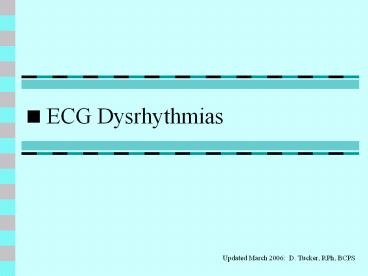ECG Dysrhythmias - PowerPoint PPT Presentation
Title:
ECG Dysrhythmias
Description:
ECG Dysrhythmias Updated March 2006: D. Tucker, RPh, BCPS Overview ECG waveforms Normal sinus rhythm Asystole Bradycardia Ventricular fibrillation Ventricular ... – PowerPoint PPT presentation
Number of Views:313
Avg rating:3.0/5.0
Title: ECG Dysrhythmias
1
ECG Dysrhythmias
- Updated March 2006 D. Tucker, RPh, BCPS
2
Overview
- ECG waveforms
- Normal sinus rhythm
- Asystole
- Bradycardia
- Ventricular fibrillation
- Ventricular tachycardia
3
ECG Rhythm Strip
- Electrocardiogram or ECG is used to measure the
activity of the heart - ECG is used to represent the conduction of
electrical impulses from the atria to the
ventricles - ECG is used to characterize rhythms and
conduction abnormalities of the heart
4
ECG Waveforms
P Wave Electrical activation (depolarization) of the right then left atrium due to discharge from the sinoatrial (SA) node
PR Segment Passage of the impulse through the atrioventricular (AV) node and bundle of HIS
QRS Complex Electrical depolarization of the ventricles
ST Segment Plateau phase
T Wave Repolarization of the ventricle
U Wave Repolarization of the HIS-Purkinje system
5
ECG Waveforms
6
Normal Sinus Rhythm
- Normal impulse conduction through the heart
- Normal sinus rhythm (NSR) is the standard against
which all other rhythms are compared - NRS contains no ectopic or aberrant beats
7
ECG Rhythms
- Normal sinus rhythm
8
ECG Rhythms
- Asystole
- Bradycardia
- Ventricular fibrillation
- Ventricular tachycardia
9
Asystole
- Asystole is a cardiac standstill, i.e., flatline
- Asystole is the absence of electrical activity in
the venticles - Asystole usually results from a prolonged period
of cardiac arrest without resuscitation - Asystole usually means the patients life has
ended
10
ECG Rhythms
- Ventricular asystole
11
Bradycardia
- Bradycardia is when the heart is lt 60
beats/minute or when the heart rate is slower
than expected - Sinus bradycardia usually occurs as a response to
a reduced demand for blood flow - Signs and symptoms might include
- Chest pain, shortness of breath
- Hypotension, pulmonary edema, congestive heart
failure
12
ECG Rhythms
- Sinus bradycardia
13
Ventricular Fibrillation
- Ventricular fibrillation (VF) occurs as a result
of electrical impulses coming from multiple
ectopic pacemaker in the ventricles - VF results in no cardiac output as a result of
producing no effective ventricular contractions - With VF the ventricular muscle quivers instead of
contracting
14
ECG Rhythms
- Ventricular fibrillation
15
Ventricular Tachycardia
- Ventricular tachycardia (VT) is a result of 3 or
more ventricular contractions occur earlier than
expected resulting in a ventricular rate of gt10
beats/minute - VT usually preceeds VF
- Causes of VT include myocardial ischemia, heart
failure, drug toxicity from procainamide,
quinidine, or cocaine
16
ECG Rhythms
- Ventricular tachycardia
17
Name TheseECG Rhythms
C
A
D
E
B

